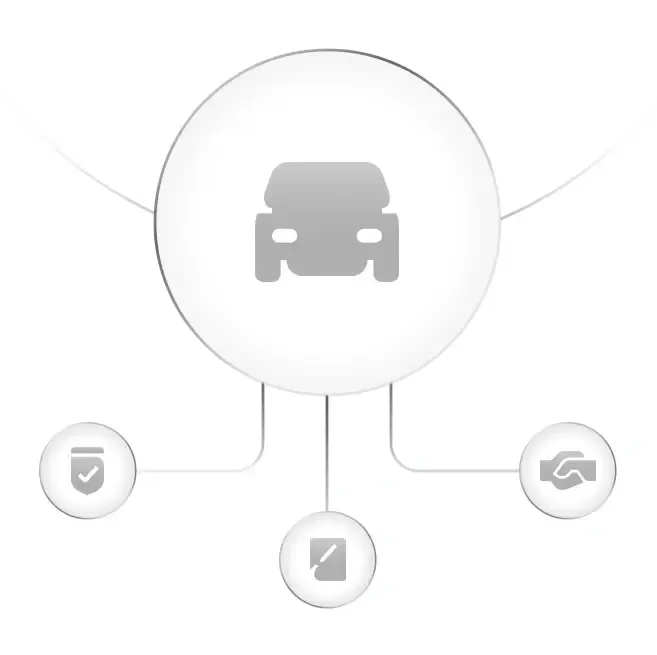Use of Company Vehicle Policy
Neglecting company vehicles, which are valuable assets, can lead to significant losses and even endanger lives. To prevent such issues use of company vehicle Policy provides a clear safety framework. It guides employees on the proper use of company vehicles, highlighting essential guidelines for safe driving, proper maintenance, and effective accident reduction strategies.

Created by
Ahmed Abdel Wahab
|
Human Resources Adviser
Share the calculator with an HR college
What’s included in the use of company vehicle policy?
The use of company vehicle policy summarizes the requirements and rules for using company vehicles. It starts by defining company vehicles based on ownership type and usage patterns (permanent or daily), then clearly states which employees are eligible to use a company vehicle and the conditions they must meet to prove their driving competency.
Next, it mentions the official use of the vehicle and the requirements for its use for otherwise purposes. It clarifies all employee duties during use, the rules they should follow while driving, and their responsibility for maintenance.
Because traffic accidents can cause stress, the employee use of company vehicle policy includes a reminder of the procedures to take in case of an accident, damage, or breakdown to the vehicle, and which party bears the responsibility for paying for damages.
Finally, the policy details the fines and penalties an employee faces in the event of vehicle misuse.
Use of Company Vehicle Policy - Table of contents
1. Objective
2. Vehicle Types
3. Vehicle Assignment Types
4. Usage Rules
5. Work Travel Guidelines
6. Maintenance Responsibility
7. Driving License
8. Traffic Test Compliance
9. Heavy Vehicles
10. Accident & Insurance
11. Return & Handover
12. GPS Tracking
13. Driving Evaluation
14. Violations & Penalties
15. Admin Authority
16. Legal Reference
Why do you need a use of company vehicle policy?
Protecting the company where an employee is injured due to vehicle misuse.
To guide employees on how to use vehicles safely and legally.
A framework that guides HR and financial decisions regarding company vehicles.
Reducing accidents, injuries, and fatalities, and lowering maintenance costs.
How do you use the model?
Download the template and review the content.
Customize it with name and logo, intended uses of vehicles and the level of usage flexibility.
Place it in a prominent location and regularly inform employees about it as a safety training.
Ensure compliance by getting use of company vehicle policy reviewed by a legal/HR expert.
See Jisr in action
Scale HR operations, manage talent, control spend – all in one platform with Jisr. Get started in weeks, not months.

FAQs
When an accident occurs in a company car, employees should prioritize safety first by checking for injuries and moving to a safe location if possible. Immediate action involves contacting the HR department or designated company contact to report the incident.
It's crucial to avoid admitting fault or guaranteeing payment to any other party without company authorization. Additionally, employees should document the scene by taking photos and noting conditions, and cooperate fully with any subsequent internal investigations or insurance processes.
An employee's use of a company vehicle for personal purposes is a recognized practice, but it's conditional upon obtaining written approval. Given that allowing personal use places responsibility on the company, businesses regulate it carefully. They permit it only as a job privilege, while strictly prohibiting certain forms, such as renting out the vehicle for financial gain.
No, only employees who meet specific criteria qualify to use a company car. These criteria include possessing a Saudi driving license before receiving the vehicle and successfully passing safety and driving tests approved by the General Department of Traffic . As a follow-up measure, the employee must receive a good evaluation in the company's periodic review of their driving behavior, fuel efficiency, and level of vehicle care.
To ensure employee safety, it's crucial to guide drivers on the importance of taking breaks during long periods behind the wheel. For instance, drivers should ideally stop after five continuous hours of driving, taking a break of at least half an hour. Furthermore, the total driving time should not exceed seven to eight hours in a single day.
A company vehicle usage policy and procedures outlines the rules for employees using company-owned vehicles for business purposes. It typically defines eligible users, clarifying requirements for driving competency. The policy details permissible professional and personal use, emphasizing safe driving guidelines, proper maintenance responsibilities, and protocols for accident or breakdown reporting.It also clarifies which party is responsible for damage costs.
Furthermore, the policy might include a table of authorized spending limits based on job rank and specifies penalties for vehicle misuse, ensuring accountability and protecting company assets from negligence or fraud.